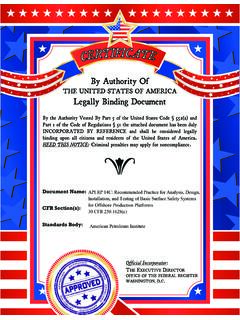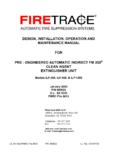Transcription of Installation & Maintenance
1 Installation &. Maintenance SELF-REGULATING. HEATER CABLE. CONTENTS. 2. GENERAL INFORMATION .. 4. How Heating Systems Work .. 4. PRODUCT SELECTION .. 4. RECEIPT & 4. Receipt .. 4. Storage .. 4. Withdrawal from Storage .. 4. CONDITIONS OF SAFE 5. Installation .. 7. Scheduling .. 7. Pre- Installation Check .. 7. Heater 7. Heater Cable Location .. 8. Straight Tracing .. 8. Spiraling .. 8. Attachment .. 9. Cutting the Heater Cable .. 9. Installation 9. SYSTEM COMPONENTS .. 12. 12. THERMAL INSULATION .. 13. Pre- Installation Checks .. 13. Installation .. 13. 14. THERMOSTATS & 14. ELECTRICAL 14. Voltage Rating .. 14. Electrical Loading.
2 14. Protection Requirements for Branch 14. Waterproofing .. 15. 15. 16. 19. Heat-up Time .. 19. Diversity Factor .. 19. OPERATION & 19. System design , Installation & Documentation .. 19. Preventive 19. Visual Inspections .. 19. Frequency .. 19. Personnel Training .. 19. Maintenance .. 20. Piping 20. DAMAGED 20. TROUBLESHOOTING .. 21. GENERAL INFORMATION. The Installation and Maintenance Manual is intended for use with Nelson Heat Trace self-regulating heating cable and component system on insulated pipes and vessels only. These instructions are suitable for use with the heating cables and components listed on sheets 5, 6 and 13.
3 For applications not specifically addressed, please contact your local representative. How Heating Systems Work An electric heating cable system uses the heater cable to replace the heat that is lost through the thermal insulation system. Replacing the lost heat allows the pipe and product inside the pipe to be kept at a constant temperature. This will keep water from freezing and bursting a pipe, or a liquid from setting up and plugging the pipe. Simple systems may turn the entire system on with a contactor or switch, while others will use a thermostat or controller with each heater cable to regulate the temperature.
4 Insulation Heater Cable Pipe Figure 1. PRODUCT SELECTION. Check and verify that the proper heater cables are being installed on each pipe and vessel. If no design / Installation documents exist, check Nelson Heat Trace design & Selection Guides to determine the proper equipment for the application. RECEIPT & STORAGE. Receipt Compare the material received against the shipping bill to verify receipt of the correct product and quantities. Inspect heating cable and components for any shipping damage. Insulation resistance tests on each spool of cable are recommended. If design documents (line lists or per circuit bills of material) exist, check the received material against the lists to verify all needed materials.
5 If no design documents exist, keep a receipt log of all materials received. Record Lot Numbers on the Heat Trace Installation Record (see Figure 15) for product traceability. Lot number coding is printed on the heating core of HLT and QLT cables, and on the first electrical jacket of all other cables. The last 2 digits designate the year of manufacture and the preceding digits represent the sequential lot numbering format. Example: 35407 would represent lot number 354 manufactured in 2007. Lot numbers are repeated every ( ). Lot numbers can also be located on each shipping spool identification label. Storage Cable and system components should be stored in a clean, dry area.
6 The equipment should be protected from mechanical damage during storage. The storage temperature range is -40 C to + 60 C (-40 F to + 140 F). Withdrawal from Storage It is recommended that a check out record be kept (in conjunction with the receipt records) on equipment as it is removed from storage. This will serve to identify material shortages before they happen as project additions often cause the use of material for other than designated piping. BOX 726 TULSA, OK 74101 TEL 918-627-5530 FAX 918-641-7336 GA-1765 Rev. 8. Sheet 4 of 23. August, 2011. CONDITIONS OF SAFE USE. Ordinary Locations: For ordinary location approvals, please refer to marking on respective product or contact manufacturer.
7 Hazardous Locations: Compliance with Safety Requirements has been assured by compliance with: NEC 2005; NFPA 70: National Electrical Code , International Electrical Code Series IEEE Std 515 -2004 Standard for the testing , design , Installation , and Maintenance of Electrical Resistance Heat Tracing for Industrial Applications IEEE Std -2005 Standard for the testing , design , Installation , and Maintenance of Electrical Resistance Heat Tracing for Commercial Applications UL. Certificate No. Coding LT: E49805 Class I, Division 2, Group ABCD. Class II, Division 2, Group FG. Class III, Division 2. Class I, Zone 1 and 2, Group IIC.
8 QLT: E49805 Class I, Division 2, Group ABCD. Class II, Division 2, Group FG. Class III, Division 2. Class I, Zone 1 and 2, Group IIC. HLT: E49805 Class I, Division 2, Group ABCD. Class II, Division 2, Group FG. Class III, Division 2. Class I, Zone 1 and 2, Group IIC. D1-LT: E49805 Class I, Division 1, Group BCD. Class II, Division 1 Group EFG. Class III. D1-HLT: E49805 Class I, Division 1, Group BCD. Class II, Division 1 Group EFG. Class III. FM. Certificate No. Coding LT: Class I, Division 2, Group BCD. Class II and III, Division 2, Group G. Class I, Zone 1, Group IIC. HLT: Class I, Division 2, Group BCD. Class II and III, Division 2, Group G.
9 Class I, Zone 1, Group IIC. D1-LT: 3004655 Class I, Division 1, Group BCD. Class I, Zone 1, Group IIB. D1-HLT: 3004655 Class I, Division 1, Group BCD. Class I, Zone 1, Group IIB. CSA. Certificate No. LT: LR 42104 Coding HLT: LR 42104 Class I, Division 1 and 2, Group BCD. Class II, Division 1 and 2, Group EFG. Class I, Zone 1 and 2, Group IIB+ H2. Zone 1, Ex e II T6* * (T5* * ). Class I, Division 1 and 2, Group BCD. Class II, Division 1 and 2, Group EFG. Class I, Zone 1 and 2, Group IIB+ H2. Zone 1, Ex e II T3. BOX 726 TULSA, OK 74101 TEL 918-627-5530 FAX 918-641-7336 GA-1765 Rev. 8. Sheet 5 of 23. August, 2011.
10 Compliance with the Essential Health and Safety Requirements has been assured by compliance with: ATEX: EN 60079-0:2006, EN 60079-30-1:2007, EN 61241-0:2006, EN 61241-1:2004. IECEx: IEC 60079-0:2004, IEC 60079-30-1:2007, IEC 61241-0:2004, IEC 61241-1:2004. KEMA. Certificate No. Coding LT: KEMA 07 ATEX0124 II 2 G Ex e II T6* * (LT3, LT23, LT5, LT25). II 2 D Ex tD A21 T 80 C. 0344 II 2 G Ex e II T5* * (LT8, LT28, LT10, LT210). II 2 D Ex tD A21 T 95 C. QLT: KEMA 07 ATEX0124 II 2 G Ex e II T3. 0344. II 2 D Ex tD A21 T 195 C. HLT: KEMA 07 ATEX0124 II 2 G Ex e II T3. 0344. II 2 D Ex tD A21 T 195 C. LLT: KEMA 08 ATEX0147U* II 2 G Ex e II T5.











